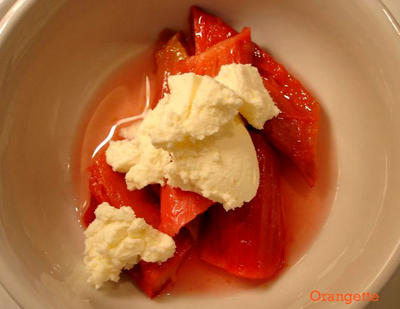Rhubarb: better late than never, and right on time
I’ve been horribly distracted.
Between radishes and fennel, beets and blueberries—not to mention the gaping black hole that was my thesis, which, now completed(!), shall no longer loom darkly over Orangette—I almost forgot about rhubarb, my favorite fruit that’s actually a vegetable. Its puckery yet delicate flavor is, to me, the epitome of spring, and the sound of a sharp knife slicing through its purply-red stalks—like a fleshy, feminine version of celery—never ceases to satisfy. Nonetheless, I’ve had a wandering eye; the generous spread of springtime fruits and vegetables has a way of making a girl terribly fickle. But a couple of days ago—and not a moment too soon—my gaze fell on a very patient basket of rhubarb, languishing on a shelf in the produce section. And that very same day, a strangely fortuitous rhubarb-related fact tumbled into my lap.*
Perhaps you have heard of Carolus Linnaeus, the Swedish botanist who invented the modern scheme of taxonomy? We have Linnaeus to thank for bringing a little Latin into our daily lives by creating, in 1758, the system by which we classify plants and animals into genera and species. What you may not know, however, is that while Linnaeus may have completely revolutionized the biological sciences, what he really cared about was rhubarb.
In Linnaeus’s time, Sweden was very poor. Being a wise scientist and resourceful citizen, he cooked up a scheme to import exotic plants and animals, hoping that they could be raised for profit in his country. Among his many experiments and test crops—from tea to coffee, ginger, coconuts, silkworms, cotton, clams, and rhubarb—all were failures except the last, and late in his life, Linnaeus would be recorded as saying that the introduction of rhubarb to Sweden was his proudest achievement. Apparently, even the most enduring and far-reaching scientific inventions pale in importance next to a rosy stalk of rhubarb. This was a man who clearly had his priorities in order.
He also must have direct access to powers of divine intervention. As fate would have it, May 23, the day that rhubarb caught my eye and brought me back to my senses, was Linnaeus’s birthday. So I celebrated in the best way that I could imagine, with a warm bowl of baked rhubarb and fresh ricotta. It may have been a big day for Linnaeus and the Swedes, but truth be told, I had plenty to celebrate myself—like a reunion with rhubarb.
*Thank you, Garrison Keillor and The Writer’s Almanac. 
Baked Rhubarb with Fresh Ricotta
Adapted from Saveur
As with most rhubarb recipes, this one calls for what seems like a truckload of sugar. Be not afraid, and don’t skimp: you’ll need it to counter the vegetable’s natural sourness. This rustic recipe yields wonderfully tender, sweet-tart stalks, which you’ll serve in a bath of their syrupy, orange-accented cooking juices. Fresh ricotta makes for a humble and delicious accompaniment—rich, creamy, and with the texture and mild dairy sweetness of a good cheesecake. If you don’t have access to good-quality fresh ricotta, skip it entirely; don’t use the bland supermarket stuff.
6 good-sized stalks rhubarb, trimmed and cut into 3- to 4-inch pieces
1 1/3 cups granulated sugar
Zest of 1 orange
Fresh ricotta
Preheat the oven to 325 degrees Fahrenheit. Put the rhubarb into a medium baking dish, and sprinkle the sugar and orange zest on top of it. Add enough water to the baking dish to just cover the rhubarb (about 4 cups; the rhubarb will likely float). Transfer the dish to the oven, and cook, uncovered, until the rhubarb is very soft but not falling apart, 45 minutes to 1 hour.
Using a slotted spoon, transfer the rhubarb to a large shallow bowl. Pour the juices from the baking dish into a medium saucepan. Boil the juices over medium-high heat until thick and syrupy, 15-20 minutes; then pour the reduced juices over the rhubarb in the bowl.
Serve the rhubarb warm or at room temperature, with a generous spoonful of fresh ricotta.
Serves 4-6.

